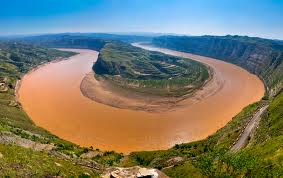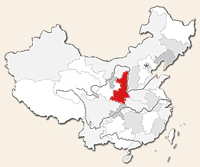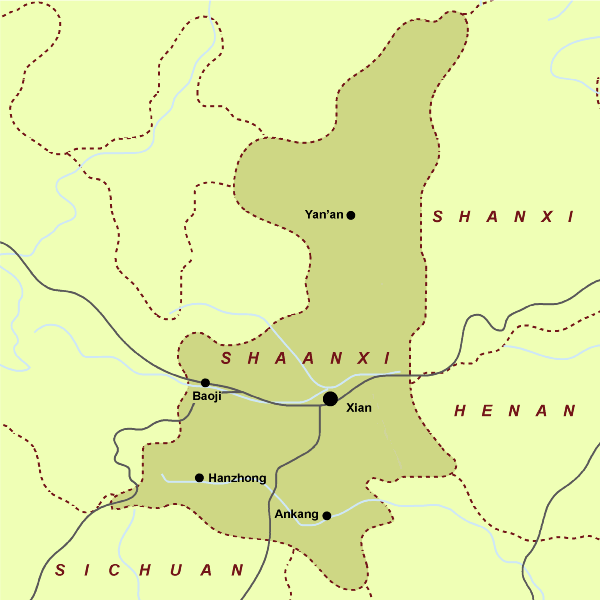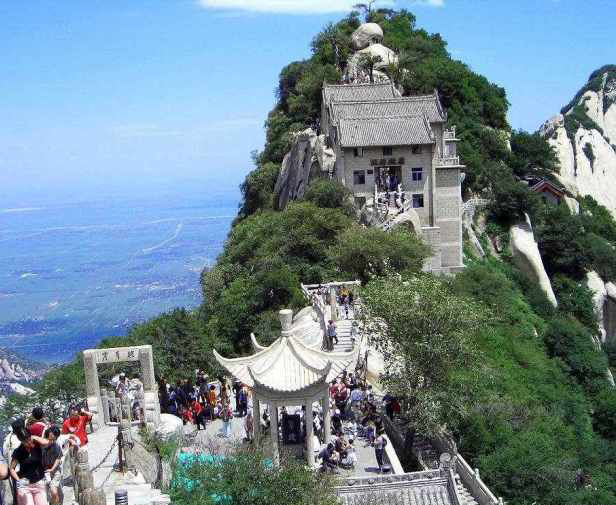Read more about
Baoji Shaanxi.
Shaanxi Province China
Shaanxi is located in the heart of China’s territory and including most of the middle reaches of the
Yellow River,
Shaanxi Province is one of the birthplaces of Chinese primitive human
beings and national culture.Shaanxi has also been the political, economic
and cultural center of several dynasties in the country's history. Xi'an
is the Capital city of
Shaanxi
 |
| The Yellow Rivers Northern China |
It is from Shaanxi that Chinese civilization first spread out to the outside
world. It is also a sacred place of the revolution in the country's
modern history and Shaanxi province plays an important role in the
existence and development of the Chinese nation and history.
 |
| Shaanxi China |
History
About
800,000-1,200,000 years ago, Lantian Man had already lived their lives
on this land by using simple tools, collecting fruits and seeds as well
as hunting animals. The Banpo Ruins, a representative site of
matriarchal clan society dating back 5,600-6,700 years ago, was found in
the eastern part of its present capital city, Xian.
When China’s first
dynasty, Xia Dynasty (21st -17th century BC) was built, the Bao State, Hu State and Luo
State were set up here. When the first unified and power-centralized
dynasty of China, Qin Dynasty (221 BC - 207 BC) was founded, its capital was chosen from this land. Later, several other dynasties, such as the Han Dynasty (206 BC - 220) and
Tang Dynasty
(618 - 907), set up their capitals on this land, specifically the
province's capital city, making it a world famous ancient capital city.
 |
| shaanxi China |
Three
differing Parts
Shaanxi
Province is divided into north, central and southern parts,
differing in geographical, historical, cultural and climatic
backgrounds, etc.
Located to the north of the Beishan Mountains,
Northern Shaanxi mainly consists of the Loess Plateau and Maowusu Desert
and has a temperate subarid climate.
Northern Shaanxi was an important frontier
stronghold in ancient times as well as one of the country's sacred
places of the modern-day revolution..
Northern part boasts historical relics like
Zhenbeitai of the Great Wall and revolutionary relics like the Site of
the Former Offices of the CCP Central Committee -Yangjialing. The famous
cities here are Yulin and Yan’an.
 |
| Mt. Huashan |
Central Shaanxi, or Guanzhong,
is located to the south of the Beishan Mountains and north of the
Qinling Mountains. It enjoys a temperate monsoon climate. Most of its
landforms are plains and terraces. This is a place of deep national
culture and rich historical relics, especially the ‘living history
museum’, Xian itself. Exhibited in this 'museum' are various cultural
relics like the eighth miracle of human beings, the Terracotta Warriors
and Horses of the Qin Dynasty; China’s largest and best-preserved
ancient City Wall; Drum Tower; Bell Tower; Big Wild Goose Pagoda and Qianling Mausoleum,
the joint burial mausoleum of the country's first and only Empress, Wu
Zetian and her husband Emperor Gao Zong of the Tang Dynasty. Even
natural scenic spots like Mt. Huashan and Mt. Lishan here have some
fairy tales and historical stories behind them.
Xian is also the eastern
terminus of the ancient Silk Road, a road connecting China and the outside world in ancient times.
Southern
Shaanxi refers to the region south of the Qinling Mountains, which
belongs to subtropical monsoon climate zone. Covered by mountains,
valleys and plains, this region has beautiful natural scenery such as
Nangong Mountain National Forest Park, Zhashui Cave and Yinghu Lake. As a
part of the Kingdom of Shu during the Three Kingdoms Period (220 -
280), the central and western parts of the region were greatly
influenced by Shu culture, hence boasting relics related to Shu, such as
the Wuhou Memorial Temple and the Ancient Plank Road. Controlled by the
Qin and Chu States in the Spring and Autumn and Warring States Period
(770 BC - 221 BC), its eastern part belongs to the Qin and Chu culture
zone.
Shaanxi Province Agriculture: Shaanxi province is a
traditional agricultural place. Crops harvest once a year in north part
of this province, thriple harvest in two years are practices in
Guangzhong Plain and double harvest system in the south. Shaanxi not
only raises most milk goats in China but also products first class
strains of cow and donkey.
Shaanxi Province Industry: Shaanxi
is a well developed province in west China and its industries mainly
includes machinery, textile, space technology, pharmacy, energy,
chemicals and food production.
Tourist Resources of Shaanxi Province: Shaanxi has numerous historical and cultural relics: the world famous Terracotta Warriors,
regarded as a part of Mausoleum of the First Emperor of Chinese
history, Qin Shi Huang Di, Dayan Pagoda (Big Wild Goose Pagoda) and
Xiaoyan Pagoda built in Tang Dynasty, Mt. Huashan, one of the five
sacred mountains in China, a legendary place known for its spectacular
steepness, and Forest of Stone Steles, a treasure of Chinese
calligraphy. Other attractions are Great Mosque and the Muslim Street,
Mt. Lishan, Banpo Museum and etc.
See ratings  af Northwest China , Do you have rice or praise for this Bed and Breakfast, Write your review
af Northwest China , Do you have rice or praise for this Bed and Breakfast, Write your review 